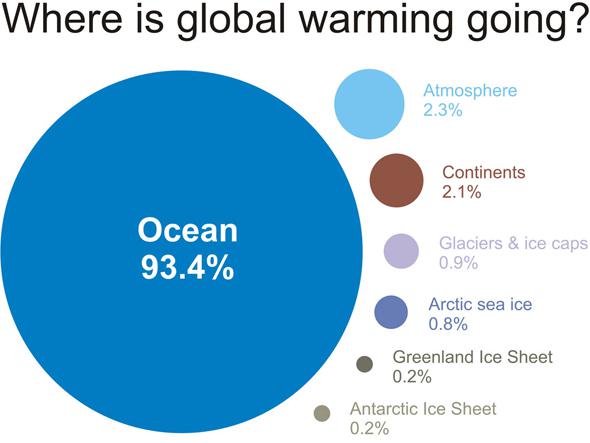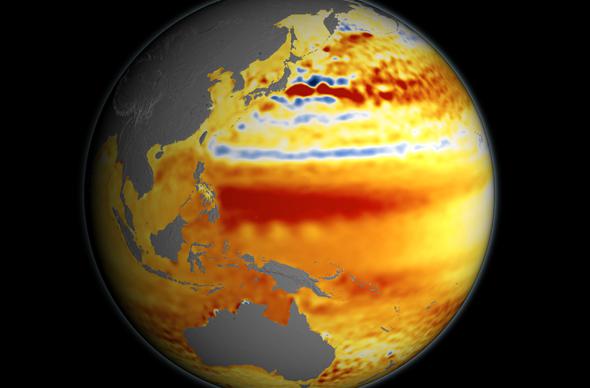Do you think global warming is something that only affects us sometime in the future, decades or centuries from now?
Think again. Our planet heating up is affecting us now, and has been for decades. We’re already seeing a lot of serious problems due to it: extreme weather, more devastating hurricanes, wildfires, and sea level rise.
Of all these, the last seems most like science fiction. Seriously, the levels of the ocean are going up? It can’t be much, right?
Think again, again. NASA just released results from several satellite observations going back to 1992. Those 23 years of data show that the oceans of the planet have risen substantially in that time: more than 6 centimeters (2½ inches) on average, with some places on Earth seeing more than 22 centimeters (9 inches)!
This animation shows where the levels are going, and by how much:
The global sea level rise is driven by two major factors: One is that as water warms, it expands, raising the sea level. The other is that Greenland and Antarctica are melting, dumping 450 billion tons of water into the oceans every year. Every year.

Photo by NASA Earth Science News Team
So overall sea level is rising, but in some places it’s rising faster than others. For example, in the Pacific, heat travels east to west, so the eastern coasts of the Philippines and Japan have seen huge jumps in sea level the past two decades. Interestingly, sea levels have dropped in some places. Off the northeastern shore of the U.S. you can see a drop. But in that case it’s because the Gulf Stream, a major warm ocean current, has shifted north somewhat, so levels have risen in the north but dropped in its wake to the south.
But those drops are highly localized. Globally, levels are on the rise.

Drawing by Skeptical Science
The cause of all this is obvious and very real: global warming. As human activity—primarily dumping 40 billion tons of carbon dioxide into the atmosphere every year—causes the Earth’s surface temperature to go up, a lot of that energy is absorbed by the oceans, causing them to expand. Some of it is absorbed at the poles, melting ice there.
Sea ice melting at the North Pole is bad enough, but the land ice melting is nothing short of catastrophic. Climatologists have already shown that the melting of the West Antarctica ice sheet may be unstoppable. We may be locked in—that is, inevitably going to suffer from—a full meter of sea level rise, 3 feet. This may take a century or more, but it’s coming. And while that may seem like a long time, think of it this way: A meter per century is a centimeter every year, an inch every 2½ years.
Mind you, that’s vertical rise. Look at the slope of a beach and you can see that a small rise vertically means a lot of horizontal reach to the ocean, too. We’ll see beaches disappear, coastlines changed. More immediately, we’ll see storm surges do far more damage as it takes less rise in the water levels to inundate cities. Remember what the surge from Hurricane Sandy did to NYC? We’ll be seeing more and more of that.
This is the new normal. And the scary thing is not so much that the new normal is bad, it’s that with more warming, rising sea levels, and changing weather patterns, the new normal will continue to get worse. There may not be a normal any more.
Just as a reminder: With only a single exception, none of the GOP presidential candidates has a reality-based view on global warming (the exception is George Pataki, who has no chance of winning), and those views range from unsupportable by facts to unhinged in the extreme. Even those of them who admit it’s real think it’s not human caused, or that we can’t do anything about it without hurting the economy (and that is 100 percent ultra-grade fertilizer; it’s worse to wait). Even this far out it seems certain the House will go GOP again in 2016, so having a climate-change-denying president will mean at least four more years of inaction bolstered by the smoke and mirrors of the noise machine.
And don’t forget that the GOP in the House is still trying to eviscerate NASA’s Earth science budget, which goes in large part to monitoring the effects of global warming. Why? Simply put, they deny the reality all around them.
And all that time, the temperatures will rise, the glaciers will melt, the sea levels will rise, and we’ll be that much deeper into a catastrophe that is already well under way.
